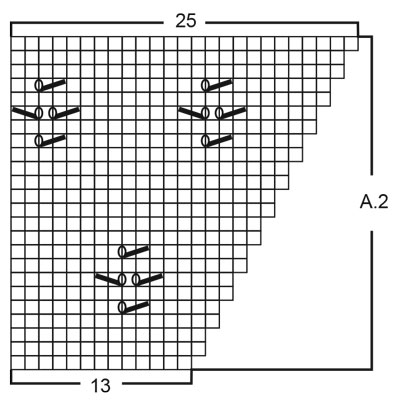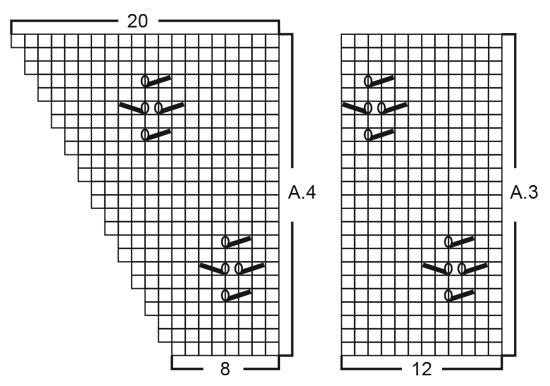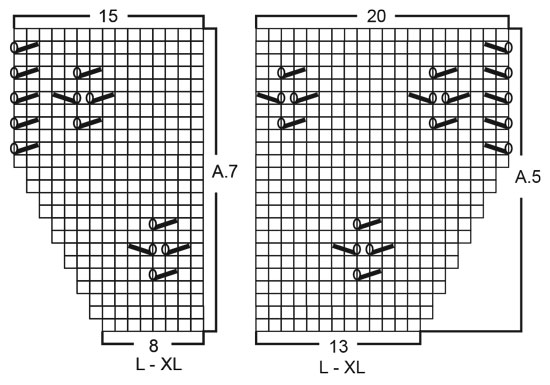Rivage Top |
|||||||||||||
 |
 |
||||||||||||
Knitted top with raglan in DROPS Safran. Piece is knitted top down with lace pattern on sleeves. Size: S - XXXL
DROPS 199-23 |
|||||||||||||
|
---------------------------------------------------------- EXPLANATION FOR THE PATTERN: ---------------------------------------------------------- GARTER STITCH (worked in the round): 1 ridge vertically = 2 rounds, i.e. knit 1 round and purl 1 round. PATTERN: See diagrams A.1 to A.7. Choose diagram for your size (applies to A.5, A.6 and A.7). INCREASE TIP-1 (evenly): To calculate how to increase evenly, use the total number of stitches on row (e.g. 124 stitches) and divide stitches by number of increases to be done (e.g. 26) = 4.8. In this example increase by making 1 yarn over after approx. every 5th stitch. On next round knit yarn overs twisted to avoid holes. RAGLAN: Increase for raglan in every transition between front/back piece and sleeves as explained below: Increase after the marker thread like this: knit 1, make 1 yarn over. Increase before the marker thread like this: work until 1 stich remain before the marker thread, make 1 yarn over, knit 1. You increase 2 stitches at each marked thread, and a total of 8 stitches on the round. On next round knit the yarn overs to make holes. Then work the new stitch in stockinette stitch on body and in lace pattern on sleeves. INCREASE TIP-2 (applies to sides of body): Work until 3 stitches remain before marker thread, make 1 yarn over, knit 6 (marker thread is in the middle of these 6 stitches), make 1 yarn over (= 2 stitches increased at the marker thread and 4 stitches increased in total on round.) On next round knit yarn overs twisted to avoid holes. Then work the new stitches in stockinette stitch. ---------------------------------------------------------- START THE PIECE HERE: ---------------------------------------------------------- TOP - SHORT OVERVIEW OF THE PIECE: Neck edge and yoke are worked in the round on circular needle, top down. Divide yoke for body and sleeve edges. Continue body in the round, top down. Work sleeve edges in the round on double pointed needles, top down. NECK EDGE: Cast on 120-124-128-132-138-146 stitches on circular needle size 2.5 mm = US 1,5 with Safran. Work 3 ridges in GARTER STITCH in the round - read explanation above. Knit 1 round while increasing 6-26-22-38-32-44 stitches evenly - read INCREASE TIP-1 = 126-150-150-170-170-190 stitches. Knit 1 round (knit yarn overs twisted). Then work yoke as explained below. YOKE: Switch to circular needle size 3 mm = US 2,5. Insert 4 marker threads in piece as explained below (without working the stitches). Use marker threads later when increasing for raglan. Insert 1 marker thread at beginning of round, count 23 stitches (= sleeve), insert 1 marker before next stitch, count 40-52-52-62-62-72 stitches (= front piece), insert 1 marker thread before next stitch, count 23 stitches (= sleeve), insert 1 marker thread before next stitch. There are 40-52-52-62-62-72 stitches after last marker thread on back piece. Work first round as follows: increase for RAGLAN after the marker thread – read explanation above, work A.1 over the next 21 stitches (= sleeve), increase for raglan on each side of marker thread, work in stockinette stitch until 1 stitch remains before next marker thread (= front piece), increase for raglan on each side of marker thread, work A.1 over the 21 stitches (= sleeve), increase for raglan on each side of marker thread, work in stockinette stitch until 1 stitch remain before marker thread at the beginning of round (=back piece), increase for raglan before marker thread. Continue pattern like this in stockinette stitch on front and back piece and A.1 on sleeves. REMEMBER THE KNITTING GAUGE! AT THE SAME TIME continue increase for raglan every other round until increase has been done 25-25-31-31-37-37 times in total at every marker thread (including increase explained on first round). Work the new stitch in stockinette stitch on front and back piece and in lace pattern the way diagrams show on sleeves. When A.1 has been worked 1 time vertically, continue lace pattern on sleeves as explained below: LACE PATTERN SLEEVE: SIZE S and M: When A.1 has been worked 1 time vertically, work next round as follows over stitches on sleeves: Work A.2 (= 13 stitches), work A.3 over the next 24 stitches (= 2 repetition of 12 stitches), and finish with A.4 (= 8 stitches). When A.2 to A.4 have been worked 1 time vertically, work next round as follows over stitches on sleeves: Work A.5 (= 13 stitches), work A.6 over the next 48 stitches (= 4 repetition of 12 stitches), and finish with A.7 (= 8 stitches). When last row in A.5 to A.7 remain, divide yoke for body and sleeves as explained below ALL SIZES. SIZE L and XL: When A.1 has been worked 1 time vertically, work next round as follows over stitches on sleeves: Work A.2 (= 13 stitches), work A.3 over the next 24 stitches (= 2 repetition of 12 stitches), and finish with A.4 (= 8 stitches). When A.2 to A.4 have been worked 1 time vertically, work next round as follows over stitches on sleeves: Work A.5 (= 13 stitches), work A.3 over the next 48 stitches (= 4 repetition of 12 stitches), and finish with A.7 (= 8 stitches). When last row in A.5 to A.7 remain, divide yoke for body and sleeves as explained below ALL SIZES. SIZE XXL and XXXL: When A.1 has been worked 1 time vertically, work next round as follows over stitches on sleeves: Work A.2 (= 13 stitches), work A.3 over the next 24 stitches (= 2 repetition of 12 stitches), and finish with A.4 (= 8 stitches). When A.2 to A.4 have been worked 1 time vertically, work next round as follows over stitches on sleeves: Work A.2 (= 13 stitches), work A.3 over the next 48 stitches (= 4 repetition of 12 stitches), and finish with A.4 (= 8 stitches). When A.2 to A.4 have been worked, work next round as follows over stitches on sleeves: Work A.5 (= 13 stitches), work A.6 over the next 72 stitches (= 6 repetition of 12 stitches), and finish with A.7 (= 8 stitches). When last row in A.5 to A.7 remain, divide yoke for body and sleeves as explained below ALL SIZES. ALL SIZES: When increases for raglan are done, there are 326-350-398-418-466-486 stitches on round. Continue lace pattern as explained above until last row in A.5 and A.7 remains. Now divide yoke for body and sleeves and work last round as follows: Knit 4-1-2-0-4-3, slip the next 65-71-81-85-89-91 stitches on 1 stitch holder for sleeve, cast on 8-8-8-10-10-12 new stitches on needle (= in the side under sleeve), knit the next 98-104-118-124-144-152 stitches (= front piece), slip the next 65-71-81-85-89-91 stitches on 1 stitch holder for sleeve, cast on 8-8-8-10-10-12 new stitches on needle (= in the side under sleeve) and knit the remaining 94-103-116-124-140-149 stitches (= back piece). Yoke measures now approx. 20-20-24-24-27-27 cm = 8"-8"-9½"-9½"-10⅝"-10⅝" from cast-on edge mid front. Remove all marker threads in piece and cut the yarn. Now finish body and sleeves separately. NOW MEASURE THE PIECE FROM HERE! BODY: = 212-224-252-268-308-328 stitches. Insert 1 marker thread in each side on body, in the middle of the 8-8-8-10-10-12 stitches that were cast on under sleeves. Move marker threads upwards when working. Use them later when increasing in the sides. Begin round at one of the marker threads and work stockinette stitch in the round. When piece measures 4 cm = 1½" from division in all sizes, increase 1 stitch on each side of both markers - READ INCREASE TIP-2 (= 4 stitches increased). Increase like this every 5 cm = 2" 5 times in total in all sizes = 232-244-272-288-328-348 stitches. Work until piece measures approx. 28-30-28-30-29-31 cm = 11"-11¾"-11"-11¾"-11⅜"-12¼" from division (or desired length, approx. 2 cm = ¾" remain until finished measurements). Knit 1 round while increasing 56-60-68-72-80-84 stitches evenly = 288-304-340-360-408-432 stitches. This is done to avoid the rib to be worked, from contracting. Switch to circular needle size 2.5 mm = US 1,5. Work rib in the round = knit 2/purl 2 for 2 cm = ¾". Bind off stitches with knit over knit and purl over purl. Top measures approx. 54-56-58-60-62-64 cm = 21¼"-22"-22¾"-23⅝"-24⅜"-25¼" from shoulder and down. SLEEVE EDGES: Slip the 65-71-81-85-89-91 stitches from stitch holder in one side of piece on double pointed needles size 2.5 mm = US 1,5 and pick in addition up 1 stitch in each of the 8-8-8-10-10-12 new stitches cast on under sleeve = 73-79-89-95-99-103 stitches. Work 3 ridges in the round. Bind off by knitting. Work the other sleeve edge the same way. |
|||||||||||||
Diagram explanations |
|||||||||||||
|
|||||||||||||

|
|||||||||||||

|
|||||||||||||

|
|||||||||||||

|
|||||||||||||

|
|||||||||||||

|
|||||||||||||
|
Have you made this or any other of our designs? Tag your pictures in social media with #dropsdesign so we can see them! Do you need help with this pattern?You'll find tutorial videos, a Comments/Questions area and more by visiting the pattern on garnstudio.com. © 1982-2024 DROPS Design A/S. We reserve all rights. This document, including all its sub-sections, has copyrights. Read more about what you can do with our patterns at the bottom of each pattern on our site. |
|||||||||||||





























































Comments / Questions (54)
Is het patroon van de trui met lange mouwen gelijk aan die met korte mouwen? Ik twijfel of ik korte of lange mouwen zal doen. Dan kan ik beginnen en als laatste besluiten of ik de mouwen lang ga maken.
14.04.2024 - 14:38DROPS Design answered:
Dag Yvonne,
Ja, beide patronen zijn, op de lengte van de mouwen na, verder gelijk aan elkaar.
15.04.2024 - 21:19Wenn die Raglanzunahmen fertig sind ,werden die Maschen dann wieder rechts gestrickt? Und laufen die Umschläge nur innerhalb des Strickdiagramms weiter? Liebe Grüße Gudrun Liedtke
17.02.2024 - 18:33DROPS Design answered:
Liebe Frau Liedtke, wenn die Raglanzunahmen für Rumpf fertig sind, strickt man die Maschen rechts weiter, und bei den Ärmeln stricken Sie wie in A.5/A.7 gezeigt (damit nur Löcher bleiben, aber ohne weitere Zunahmen). Viel Spaß beim stricken!
19.02.2024 - 09:10There is no chart 6 for size large. Am I missing something?
08.11.2023 - 17:17DROPS Design answered:
Dear Mrs Kerr, A.6 is not worked in L, see description of diagrams under LACE PATTERN SLEEVE: ... SIZE L and XL: . Happy knitting!
09.11.2023 - 08:12Buongiorno
19.07.2023 - 00:18Bonjour, je suis en train de faire mon échantillon et je me pose la question de l\'aisance recommandée pour ce t-shirt afin de choisir au mieux la taille à tricoter. Cordialement, Marie
25.06.2023 - 18:13DROPS Design answered:
Bonjour Mme Sirlin, nous n'utilisons pas ce concept d'aisance, mesurez un vêtement similaire que vous avez et dont vous aimez la forme et comparez ces mesures à celles du schéma; c'est la façon la plus simple de choisir votre taille et de décider ainsi quel type d'aisance (plutôt serré ou plutôt lâche) vous préférez. Bon tricot!
26.06.2023 - 09:14Guten Tag Wird bei der Grösse S Diagramm A5 noch einmal zugenommen? Habe leider zu viele Maschen auf der Nadel . Herzlichen Dank
08.06.2023 - 09:10DROPS Design answered:
Liebe Gabi, wenn A.2 bis A.4 einmal in der Höhe gestrickt wurden, wurde es nur 24 Mal für Raglan zugenommen; bei der 1. Reihe A.5 sollen Sie noch die letzte Raglanzunahmen stricken, so sind es 14 M in A.5 und 9 M in A.7. Viel Spaß beim stricken!
08.06.2023 - 09:56Jeg ser at mange har spurt om dette, men svarene forklarer ikke godt nok. Det gjelder de siste 10 omfarene i A5 og A7 (str L). Da er raglanøkning ferdig. Skal man lage kast og to sammen nedover på begge sider (erme og rygg/foran)? Hva med de fire maskene imellom (selve raglanøkningen og to masker mellom)? For de er jo utenfor diagrammet.. Presiserer at det kun gjelder de siste ti omganger etter at 31 økninger er ferdig.
06.06.2022 - 23:1637 country flag Astrid wrote: Hei! Strikker i str M og ved A5-A7 er man være ferdig med raglan. På starten og slutten av ermene er det felling og hullmønster. På bildet ser det ut som det fortsett er hullmønster på starten og slutten av bak-og forstykket også, men ser ikke noe i oppskriften om det. Skal jeg da ordne hull, også felle rett etterpå der også? Slik at det blir hullmønster på hver side av merkemaskene.
20.05.2022 - 21:23DROPS Design answered:
Hei Reidun. Det ble gitt et svar til Astrid/10.06.2021. Om du har samme spørsmål som henne kan du se vårt svar som ligger under hennes spørsmål/ evnt se under. Eller hadde du et annet spørsmål? Slik står det i oppskrfiten: Det økes 2 masker ved hver merketråd og totalt 8 masker på omgangen. På neste omgang strikkes kastene rett slik at det blir hull = Hullmønster på hver side av "raglanlinjen", i tillegg kommer hullmønstret fra diagrammene. mvh DROPS design
23.05.2022 - 08:21Tak zrobiłam, tylko nie rozumiem polecenia, żeby zacząć tył/ przód od jednej z nitek markerów czyli na środku 8 dobranych oczek pod rękawem ? "zaczynając okrążenie od jednej z nitek markerów"? Tzn. po 4 dobranym oczku pod rękawem?
07.05.2022 - 11:53DROPS Design answered:
Witaj Kasiu, dokładnie tak. Pozdrawiamy!
08.05.2022 - 15:32Witam, mam pytanie czy zaczynając przód/ tył od jednej z nitek markerów, czyli począwszy od czwartego oczka tzn. połowy 8 nabranych pod rękawem trzeba zmienić druty? Jak to zrobic, bo na tych które do tej pory przerabiałam karczek pozostają oczka. Czy przerabiać tymi samymi ale jak?
06.05.2022 - 12:11DROPS Design answered:
Witaj Kasiu, nie zmieniasz drutów, przerabiasz dalej na tych samych drutach, czyli drutach z żyłką nr 3. Oczka na rękawy powinnaś zdjąć wcześniej na nitki, zostaje do przerabiania tylko tył i przód. Spójrz jeszcze na video TUTAJ. Pozdrawiamy!
06.05.2022 - 16:01